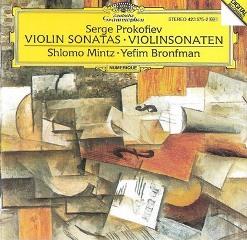Sergei Prokofiev - Violin Sonatas (1988)
Sergei Prokofiev - Violin Sonatas (1988)

Sonata for Violin and Piano no 1 in F minor, Op. 80 1. Andante assai 2. Allegro brusco 3. Andante 4. Allegrissimo - Andante assai, come prima Sonata for Violin and Piano no 2 in D major, Op. 94bis 1. Moderato 2. Presto - Poco meno mosso - Tempo I 3. Andante 4. Allegro con brio - Poco meno mosso - Tempo I - Poco meno mosso - Allegro con brio Shlomo Mintz (Violin) Yefin Bronfman (Piano)
Sonata for violin & piano No. 1 in F minor, Op. 80. Cast in four movements of approximately equal length and lasting about a half-hour, this tormented Sonata for violin and piano must rank with Prokofiev's finest works in any genre. The Andante opening panel begins with an ominous theme in the bass on the piano, the death-rattle sounds of the violin soon entering overtop it. The mood remains tense as the violin struggles to steal center stage from the piano, finally doing so with a theme that cries out painfully. Eventually the music turns ethereal when the piano gently plays the opening theme in the upper register, while the violin delivers eerie, gossamer runs that slither about hauntingly. The movement ends softly but chillingly. A hard-driving Allegro brusco follows, its main theme slashing and harsh as the piano and violin exchange angry dissonances and crushing chords. An alternate theme imparts a sense of nobility and hope for a time, but cannot here or later dispel the sense of fear and frenzy brought on by the dominant main material. The third movement (Andante) opens with an ethereal, dreamy theme floating amid a sense of fantasy. An alternate theme, largely built on three notes that repeat obsessively, imparts a feeling of desolation, and the whole movement gradually turns darker, sounding bleak and fearful at the end. The finale, marked Allegrissimo -- Andante assai, opens with a bustling theme that seems cheerful and almost playful, but its brightness soon appears threatened by dark undercurrents and, as tension accrues from stomping bass chords from the piano, it collapses. The ending of the first movement is recalled, and the music then turns bleaker and, finally, despairing. This exceedingly profound work will yield immeasurable rewards for patient listeners.
Sonata for violin & piano No. 2 in D major, Op. 94 bis. Originally conceived as the Sonata for flute and piano (1943), this work immediately became more popular in its violin version. Even today it is still more commonly encountered in concert and on recordings than its sibling, not least because violinists outnumber flutists. Cast in four movements, this sonata transcription betrays little of its grim wartime origins, mixing Prokofiev's lyrical warmth with his playful mischief.
The first movement is marked Moderato and opens with a lovely melody on violin that seems to float lazily amid the clouds. The music springs to life in a jovial bridge passage leading to the alternate theme, also a lyrical, bright melody, but one that seems to hopscotch about. Both themes are repeated then developed, though in their working out they divulge relatively little transformation, but do show a more energetic sense. A reprise and lovely coda close out the movement.
The ensuing Scherzo, marked Presto, features that typical Prokofievian drive and mischievous abandon, the piano often seeming to propel the violin along. There are two themes in the outer sections, the first busy and impish, the second carefree and a bit less breathless. The brief trio is calmer and quite lovely in its subdued lyricism. --- Robert Cummings, Rovi
The Andante third movement features, in the outer sections, a lovely soaring theme on violin, which is just as beautiful when taken up by the piano. But it is the deliciously exotic middle section that seduces the ear: the violin's somewhat jazzy lilting theme receives a beguiling, almost Gershwinian response from the piano's upper register, forging a truly memorable melodic creation.
The finale, marked Allegro con brio, opens with a chipper melody whose festive character seems to turn to chuckles with the appearance of a bouncy second theme. An angular third melody soon appears, and there follows some imaginative development of the material and a reprise. The coda is ecstatic in its joy and wild abandon. ---Robert Cummings, Rovi
download: uploaded yandex 4shared mediafire solidfiles mega filecloudio nornar ziddu
Zmieniony (Sobota, 22 Marzec 2014 22:01)








